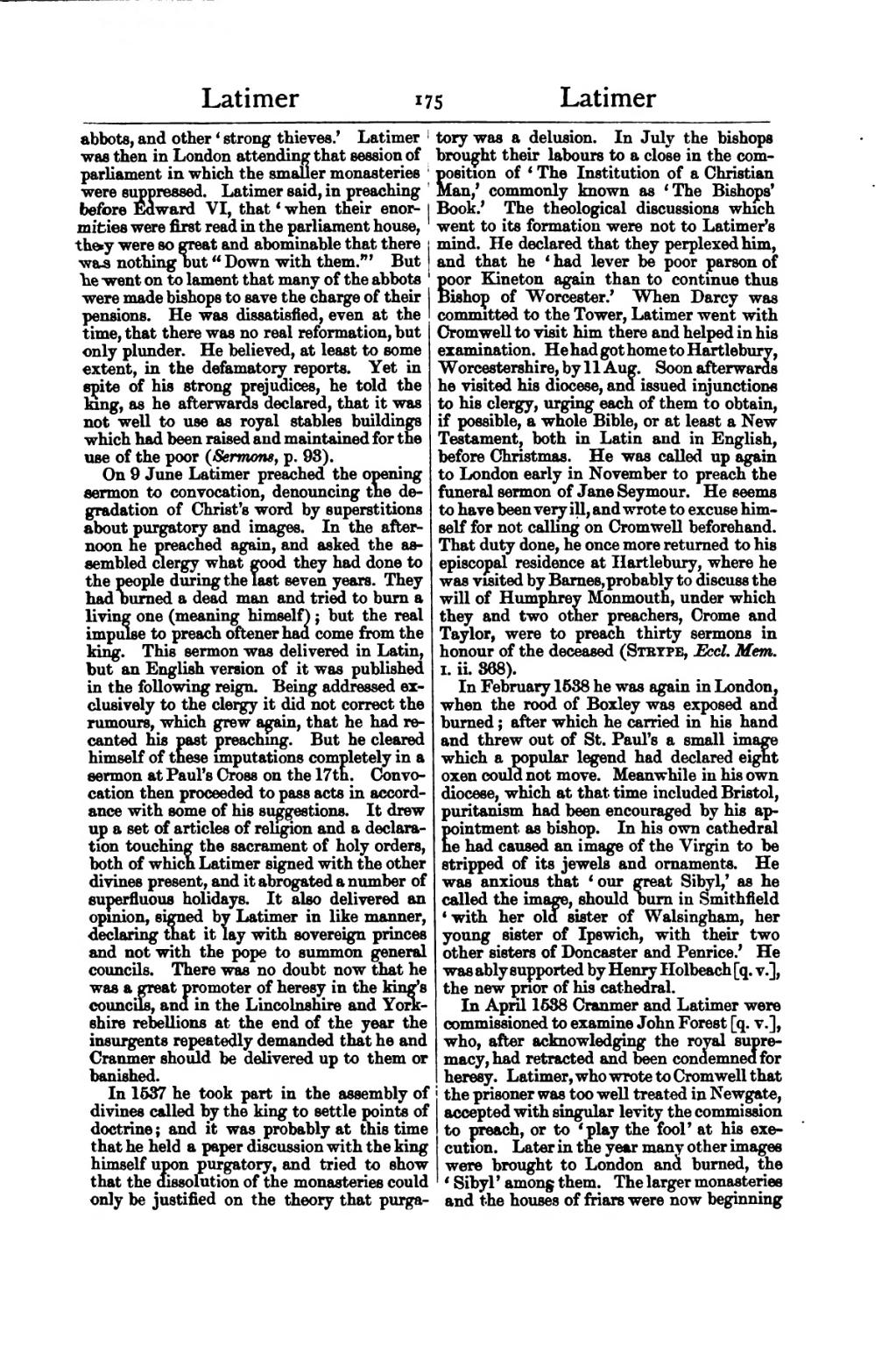abbots, and other 'strong thieves.' Latimer was then in London attending that session of parliament in which the smaller monasteries were suppressed. Latimer said, in preaching before Edward VI, that 'when their enormities were first read in the parliament house, they were so great and abominable that there was nothing but "Down with them."' But he went on to lament that many of the abbots were made bishops to save the charge of their pensions. He was dissatisfied, even at the time, that there was no real reformation, but only plunder. He believed, at least to some extent, in the defamatory reports. Yet in spite of his strong prejudices, he told the king, as he afterwards declared, that it was not well to use as royal stables buildings which had been raised and maintained for the use of the poor (Sermons, p. 93).
On 9 June Latimer preached the opening sermon to convocation, denouncing the degradation of Christ's word by superstitions about purgatory and images. In the afternoon he preached again, and asked the assembled clergy what good they had done to the people during the last seven years. They had burned a dead man and tried to burn a living one (meaning himself); but the real impulse to preach oftener had come from the king. This sermon was delivered in Latin, but an English version of it was published in the following reign. Being addressed exclusively to the clergy it did not correct the rumours, which grew again, that he had recanted his past preaching. But he cleared himself of these imputations completely in a sermon at Paul's Cross on the 17th. Convocation then proceeded to pass acts in accordance with some of his suggestions. It drew up a set of articles of religion and a declaration touching the sacrament of holy orders, both of which Latimer signed with the other divines present, and it abrogated a number of superfluous holidays. It also delivered an opinion, signed by Latimer in like manner, declaring that it lay with sovereign princes and not with the pope to summon general councils. There was no doubt now that he was a great promoter of heresy in the king's councils, and in the Lincolnshire and Yorkshire rebellions at the end of the year the insurgents repeatedly demanded that he and Cranmer should be delivered up to them or banished.
In 1537 he took part in the assembly of divines called by the king to settle points of doctrine; and it was probably at this time that he held a paper discussion with the king himself upon purgatory, and tried to show that the dissolution of the monasteries could only be justified on the theory that purgatory was a delusion. In July the bishops brought their labours to a close in the composition of 'The Institution of a Christian Man,' commonly known as 'The Bishops' Book.' The theological discussions which went to its formation were not to Latimer's mind. He declared that they perplexed him, and that he 'had lever be poor parson of poor Kineton again than to continue thus Bishop of Worcester.' When Darcy was committed to the Tower, Latimer went with Cromwell to visit him there and helped in his examination. He had got home to Hartlebury, Worcestershire, by 11 Aug. Soon afterwards he visited his diocese, and issued injunctions to his clergy, urging each of them to obtain, if possible, a whole Bible, or at least a New Testament, both in Latin and in English, before Christmas. He was called up again to London early in November to preach the funeral sermon of Jane Seymour. He seems to have been very ill, and wrote to excuse himself for not calling on Cromwell beforehand. That duty done, he once more returned to his episcopal residence at Hartlebury, where he was visited by Barnes, probably to discuss the will of Humphrey Monmouth, under which they and two other preachers, Crome and Taylor, were to preach thirty sermons in honour of the deceased (Strype, Eccl. Mem. i. ii. 368).
In February 1538 he was again in London, when the rood of Boxley was exposed and burned; after which he carried in his hand and threw out of St. Paul's a small image which a popular legend had declared eight oxen could not move. Meanwhile in his own diocese, which at that time included Bristol, puritanism had been encouraged by his appointment as bishop. In his own cathedral he had caused an image of the Virgin to be stripped of its jewels and ornaments. He was anxious that 'our great Sibyl,' as he called the image, should burn in Smithfield 'with her old sister of Walsingham, her young sister of Ipswich, with their two other sisters of Doncaster and Penrice.' He was ably supported by Henry Holbeach [q.v.], the new prior of his cathedral.
In April 1538 Cranmer and Latimer were commissioned to examine John Forest [q.v.], who, after acknowledging the royal supremacy, had retracted and been condemned for heresy. Latimer, who wrote to Cromwell that the prisoner was too well treated in Newgate, accepted with singular levity the commission to preach, or to 'play the fool' at his execution. Later in the year many other images were brought to London and burned, the 'Sibyl' among them. The larger monasteries and the houses of friars were now beginning
